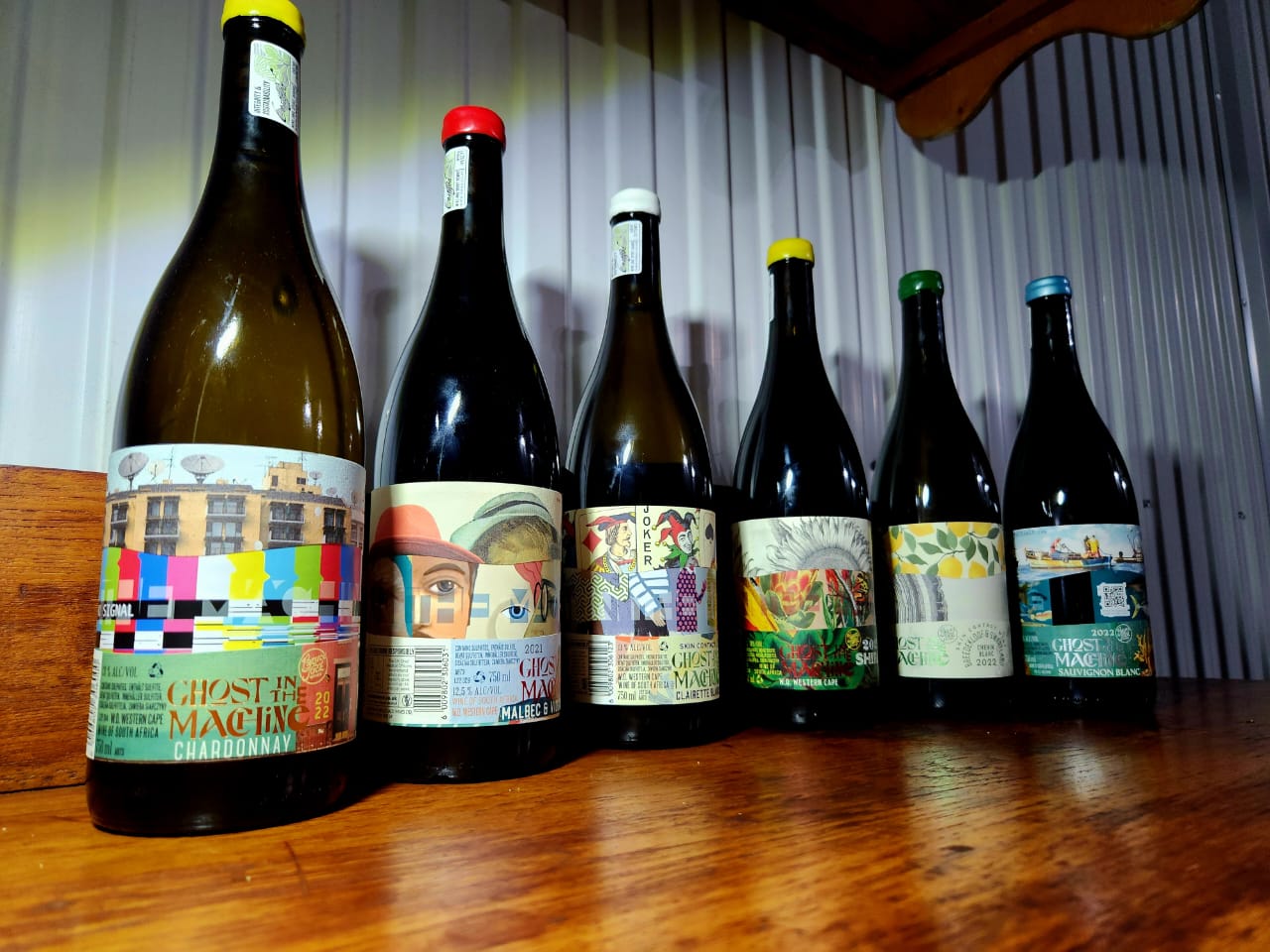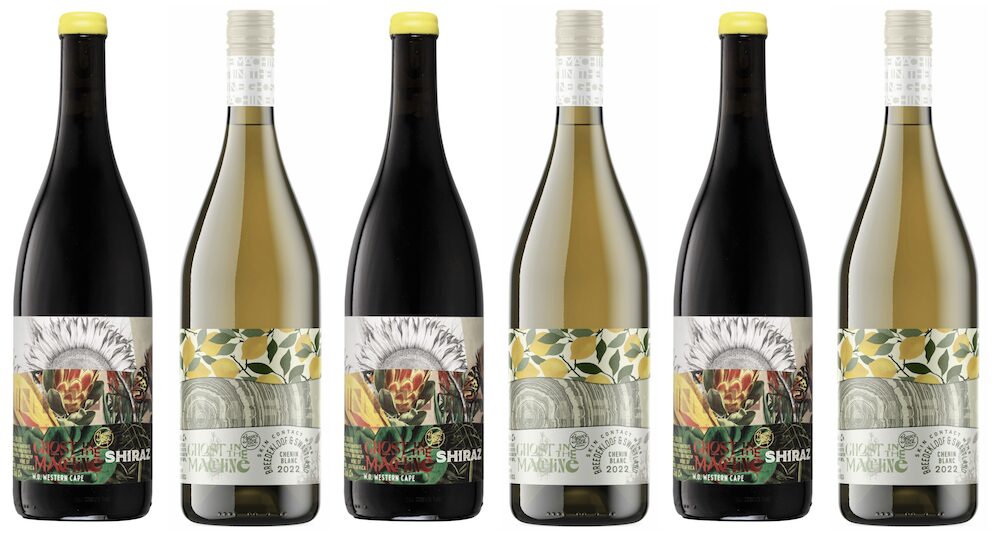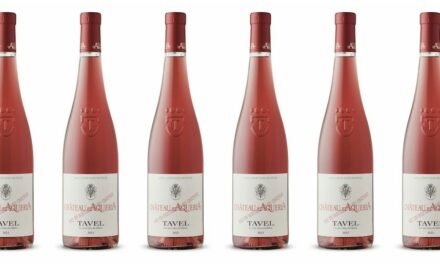I was recently sent a couple of very interesting, recently-released South African wines from Bruce Jack, and was planning to write about them both. Further investigation revealed that they were made by none other than winemaker Marlize Beyers, formerly of Niagara’s Hidden Bench winery and now making her own wine in Niagara under The Long Way Home label, but that’s a story for another day.
Below my reviews of the two Ghost In The Machine wines currently available, you’ll find my interview with the woman herself, who gives us many valuable insights into both of these wines.
2022 Ghost In The Machine Chenin Blanc “Skin Contact Wine” Breedekloof WO and Swartland WO, South Africa (Alcohol 13%, Residual Sugar 2 g/l) LCBO Vintages $29 (750ml bottle)
I simply love the complex and detailed labelling of both of these wines; they manage to be both contemporary and classically restrained at the same time. See below for more details about the labelling.
As of yesterday, the wine was rather hidden on the 1990s-era Vintages Online store, so if you’d wanted to try some, it would take a bit of digging. Today, when I checked, I found it on the usual LCBO website and in a handful of stores, which calls for celebration.
When I first tasted this wine, I was rather surprised at its resemblance to fine Chardonnay, almost Burgundy-like in its elegance. On the bouquet, I found a lot of stone fruits (peach and apricot), but also a whole load of mineral elements reminiscent of modern high-end Maçon. There’s some obvious reduction here, but that sits perfectly with the fruit profile. This medium-bodied wine is bone-dry, but expresses some delicious ripeness of fruit, with the phenolics being absolutely spot-on. Texturally, the wine is seriously broad on the palate, very alluring to a texture-fiend like me, leading to a persistent mineral finish. Absolutely delightful, and well worth tracking down.
![]()
2021 Ghost In The Machine Shiraz, Western Cape WO, South Africa (Alcohol 13%, Residual Sugar 2 g/l) LCBO Vintages $38 (750ml bottle)
Aromatically, this wine is initially all about vibrant, bright, lifted Grenache (and, to a lesser extent, Shiraz) fruit, so think about red, crunchy berries along with the darker berry fruits one would normally associate with South African Shiraz. This element gives the wine some serious aromatic lift, and it quickly becomes apparent just how much that carbonic maceration adds to the mix. Underlying this perfumed red fruit is an underlying base layer of dark, rich, ripe, spicy, peppery Shiraz, and the combination of these is key here. It makes for a wonderfully complex bouquet, and deep, rich mid-palate.
The palate, as a whole, is satisfyingly medium-full, with the spicy American oak adding more complexity here than on the nose: a gorgeously “sweet” attack on an ostensibly dry wine. The lively, juicy acidity is most appealing, with soft and supple tannins leading to a long, spicy red/black fruit finish. Terrific stuff.
![]()
(All wines are rated out of a possible five apples)
Good Food Revolution: So, I’m confused, but perhaps I’m confused easily?
You are based in Niagara, and yet you are making wines in South Africa.
Please tell us a little about how you became involved with Bruce Jack down there, and how does that work exactly?
Marlize Beyers: I met Bruce in 2002, and straight out of university, I went to work with him at Flagstone. As an impressionable new winemaker, he was, and is to this day, a mentor to me.
In 2005, my husband and I moved to Canada for a job opportunity for him, and that is how I ended up in the Niagara region. Throughout the years, I stayed connected with Bruce, and in 2017, when I left Hidden Bench, I met up with Bruce when he was here for the PIWOSA event. He mentioned that he was thinking of building a winery and asked if I would be interested in helping him set it up. When I visited South Africa in December of 2017, there was very little going on at the time, but by February we could use the facility to harvest. The Drift Estate was purchased in 1999 by Bruce and his father, David Jack and the vineyards were planted in the early 2000s. Up to 2017, the wines were custom-made at other wineries. Bruce`s dream was realised when the winery was built at the estate in 2018.
We now produce 100 to 150 tons of estate fruit every year of estate fruit and then buy fruit from growers that Bruce works with very closely, managing the vineyards.
I do day-to-day cellar management from here in Hamilton, and right now I’m assisting in “harvesting remotely” as we have already started picking Pinot and Chardonnay. Vintage is early in 2024. All the daily tasks that need to happen in the wineries —wines that need to be moved or analysed, barrels to be chosen, etc. I can do it from this side of the world, but then I travel to South Africa for harvest around the middle of February until the end of March, and I fly back in June/July to taste through all the barrels after malolactic [fermentation]. Bruce and I then make up the blends and do a first racking. When I return to Canada, I can then refer to my tasting notes, and Bruce can taste and blend as needed.
I am still involved with the Ontario industry, but I would say that the majority of my work is with Drift Estate and Black Oystercatcher. In 2021, The Drift formed a joint venture with Black Oystercatcher Winery in Elim, and that is where we make all the cool-climate Sauvignon Blanc and Semillon wines, as well as custom processing for some high-end clients.
The red and white skin-fermented Ghost in The Machine wines are produced at the Drift Estate and the Ghost Sauvignon Blanc in Elim.
GFR: What’s the story behind the Ghost in The Machine project?
MB: The Ghost in The Machine range of wines exists to allow imagination and passion in winemaking. The wines are created by careful blending of small vineyard parcels that add complexity and dimension. It is not made with a specific market in mind or follows market trends, but it has taken off tremendously. It is a kickback against AI and everything that is too modern.
GFR: Sounds right up my alley.
MB: It allows us to experiment with different techniques and vinification of off-beaten-path vineyards and achieve balanced, delicious, unique wines through blending.
GFR: Let’s talk about the 2022 Chenin first. The fruit is sourced from equal parts Breedekloof and Swartland. What is the reasoning behind that? And what types of different terroirs are we talking about?
MB: The Breedekloof Valley is very hot and dry, and the vineyards are irrigated. The fruit used in Ghost is from a block my father planted, and my brother now farms. From that same farm we make the Ghost in The Machine Clairette Blanche, which was planted in 1985 and my sister now manages.
Originally, the Chenin was going to be a single-origin wine, but then sales and popularity grew so much that we needed to blend in some of the Swartland fruit.
Swartland has more shale/schist soils, whereas the Breedekloof soils are sandy loam, planted in an ancient riverbed, dotted with smooth white river rocks.
The sandy soils make for a broader, more textured wine, where you must watch the acidity and pH, especially with skin-fermented wines, as the pH tends to go up with long skin contact. The Swartland fruit brings a mineral element and balance to the blend.
GFR: It’s a skin-contact wine, very zeitgeisty. Did you have much previous experience with skin-contact wines? And what do you believe the process brings to this particular wine?
MB: No, I did not have experience with skin-fermented whites, but my hand was somewhat forced when we started making whites at Drift. The cellar is equipped with a basket press only, which makes pressing fresh white fruit challenging. It is easier to press partially macerated/fermented skins and you achieve better recovery. The idea was not to make an orange wine but a fresh, vibrant skin macerated / fermented to bring out the aromatics in the skins and to add texture to the wine.
The fruit is destemmed, and then the whole berries are hand-sorted and transferred to the tank, with cooling at 11 – 12 degrees Celsius throughout the entire fermentation with minimal working of the skins. More like steeping. We gently wet the cap once a day and press it off before the phenolics get out of hand.
With experience, I have discovered not to keep the wine on the skins for too long. In the first attempt, we left the Chenin on the skins for 10 -12 days, but changed it to 5 – 8 days, depending upon how cold we can ferment, in subsequent years. We now start all the white varieties (Chenin, Chardonnay, Viognier, Sauvignon Blanc and Clairette Blanche) on skins, then press off to complete fermentation in barrel.
[I feel] it adds a lovely texture to the wine, so that when you taste this, I would be really curious as to your thoughts.
GFR: Would it be a fair observation to say that perhaps you were treating this wine a little more like a fine Chardonnay? It’s a delightfully intriguing wine
MB: Yes, very much so…
GFR: You use a combo of French and American oak here.
MB: It finishes fermentation in barrel, goes through full malolactic [fermentation], we do not stir the lees unless we want to get malo to finish and we do not introduce too much oxygen, so it’s made in more reductive style.
Bruce has a love affair with American oak, but I am (unsuccessfully) pulling in the opposite direction. We do not use a lot of new oak. Our typical new oak regime would be 10 – 20% new across the board. We take really good care of our barrels and have barrels that are 10 – 12 years old that are still in use.
GFR: Age worthiness?
MB: Because it is not cool-climate fruit, I would think it will be best within 5 years. It will develop further, but I feel it will be at its best within 5 years of vintage.
GFR: The 2021 Shiraz is labelled as Western Cape. Where is the fruit from specifically?
MB: The 2021 is mainly from the Drift Estate in the Overberg, blended with a small percentage of Grenache from the Upper Hemel-en-Aarde Valley.
GFR: It is a Shiraz/Grenache blend. Let’s discuss that specific cépage.
MB: We love carbonic maceration, so the Grenache and a portion of the Shiraz gets fermented as whole clusters. The anaerobic process gives that beautiful ripe strawberry and red berry fruit character that tames the concentrated, spicy Shiraz we grow at Drift Estate. We have this amazing, hot, windy, dry terroir, resulting in very small, concentrated Shiraz berries with serious pepperiness, so we blend in a component of carbonic fermented whole cluster (mainly Grenache) to bring out the berry fruit character.
GFR: What’s the oak regime, as for me, it’s the pristine fruit that really comes to the fore?
MB: Again, not much new oak, but we do use a little bit of American oak as it brings a slightly sweeter profile, although the wine is completely RS dry. The 2021 Ghost Shiraz was aged in 10% new and 7% second fill barrels, with the rest being in older, neutral barrels. Saying that, it was in the barrel for 17 months, although I do not find the oak to be in any way drying and the tannin structure of the Shiraz can stand up to it.
GFR: I find the labels quite fascinating—some of the most interesting labels I have seen in quite some time.
MB: Yes, thank you; I agree! The labels were designed by the brilliant and creative Rohan Etsebeth of Archival. He designs such beautiful labels. I admire his work so much I asked him to design the label for my The Long Way Home Ontario Chardonnay. I will send you a picture of his labels for the entire range…

GFR: Again, I get the feeling this has a decent life ahead of it. Would I be correct in my thinking?
MB: I would agree; you could age it for 7 – 10 years, although these wines just fly off the shelves, so I do not think many of the bottles are given time to age.
GFR: When it comes to food pairings, how would you enjoy these two wines the most?
MB: The Chenin pairs well with mild, creamy cheeses, much like a barrel-aged Chardonnay. Simple grilled fish and other seafood like scallops, prawns, and crab.
The Shiraz with grilled, smoky meat like lamb, game, and fire-roasted mushrooms.
GFR: Well, thank you for your time today, Marlize. I’m loving these two wines.







